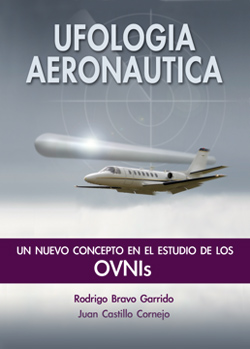
We published last week an article about the release of an important new book, Ufología Aeronáutica, by Captain Rodrigo Bravo of the Chilean Army and paleontologist and UFO researcher Juan Castillo (Mago Editores), released at the Santiago Book Fair on November 4th. We have now received additional information and excerpts from this work. Capt. Bravo is still in active service with the Chilean Army, working at its Telecommunications Branch and as a pilot with BAVE, the Army’s Aviation Brigade. His interest on UFOs began in 2000, when he wrote an official thesis titled, “Introduction to Anomalous Aerial Phenomena and its Implications for Aerospace Security.”
Capt. Bravo is best known in the U.S. for being one of the panelists at the Washington, DC National Press Club event organized by filmmaker James Fox and journalist Leslie Kean in November 2007; and more recently, as one of the contributors in Kean’s important new book, UFOs – Generals, Pilots, and Government Officials Go On the Record (Harmony Books). He is also an advisor and representative of the Army to CEFAA, the Chilean government’s official Committee for the Study of Anomalous Aerial Phenomena, which is under the General Administration of Civil Aeronautics (DGAC, the Chilean equivalent to the FAA). CEFAA’s director is Chilean Air Force General (Ret.) Ricardo Bermúdez, who was also a contributor to Leslie Kean’s book.
The book’s coauthor is Juan Castillo, curator of the Paleontological Museum of Chile and director of the Group of Paleontological Investigations of Chile (GRINPACH) as well as author of three books in that scientific field. Castillo has also pursued a long parallel career in ufology; he was one of the founders of CIO (Spanish acronym for UFO Investigation Center, one of the oldest in the country) and another UFO group called OPTO-CHILE. Among other things, Castillo investigated the mysterious megalithic monument known as “El Enladrillado,” an ancient platform of 233 rectangular stone blocks (each one weighing approximately 10 tons) assembled like bricks in a remote Andean site to the interior of the city of Talca. Some have speculated that this monument (builders, age and purpose unknown) is linked to ancient astronauts. Castillo is also an advisor to CEFAA.
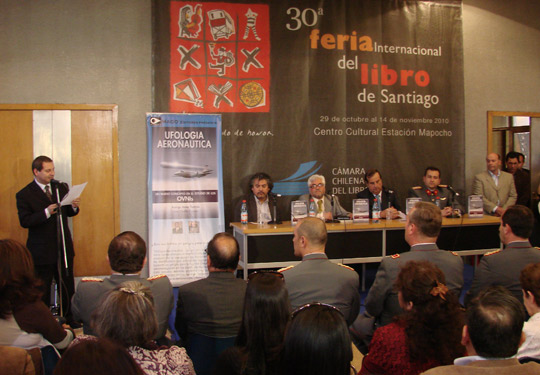
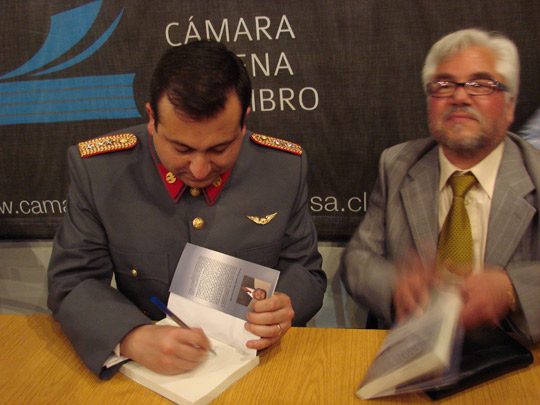
WHY PILOT CASES ARE IMPORTANT
The back-cover blurb of Ufología Aeronáutica provides some of the themes contained in the book:
“Are Unidentified Flying Objects (UFOs) a danger to aviation?
Ufological Aeronautics is a book where, for the first time, incidents involving aircraft in flight are analyzed in a simple and direct way, showing that these are the product of the interaction of Unidentified Aerial Phenomena in the world’s airspaces, and proving that this strange phenomenon poses a potential threat to the development of these types of operations.
Despite the scientific denial, civil and military pilots have provided in recent times key evidences which lead to a rapprochement of the [UFO] subject to all the sciences linked to aeronautics. These pilots, as well as air traffic and radar controllers, have witnessed these types of phenomena for many years and have contributed valuable testimonies which form part of this book.
Aeronautical Ufology is a 270-page book. The first fifty give an overview of UFO studies, discussing all the existing ufological schools and separating the known hypotheses from those implanted by investigators. We review the subject with a different view, including a degree of critical skepticism which allows the reader to observe it objectively and draw his own conclusions.”
The excerpt then gives the new classification of Aerial Encounters of the First to Fifth Kinds, which were translated in our previous article. The excerpt then asks the key question, “why is a pilot a good witness?” This is an important issue, as some skeptics—notably MSNBC consultant and space expert James Oberg—have questioned this premise, arguing that a pilot’s primary concern is to save his own skin or that of his passengers, and that therefore they tend to overreact and assume the worse when it comes to UFO sightings while in flight. However, Capt. Bravo answers the question in the following way:
“Why is a pilot a good witness? Because he has training and personal motivation, because he has experience and evaluates quickly unexpected situations; because he keeps direct contact by radio and radar (Communication); because he knows a large range of phenomena and flying machines; because he can fly at variable directions and altitudes, which allows him to have a different viewing perspective; because he handles sophisticated instruments and, finally, because he has to maintain his personal reputation, which indicates that he is unlikely to invent a case.”
FAMOUS AND LESS KNOWN PILOT CASES
The bulk of the book consists on a detailed analysis of 23 UFO pilot cases, 11 in Chile and 12 in other countries (Argentina, Australia, Belgium, Brazil, Colombia, France, Iran and USA). Each case opens with a brief data card summarizing its main elements and an illustration of the event, for instance:
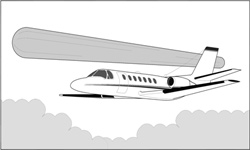
CASE Nº 20
Location: Angostura, border of VI Region, Chile
Date: March 27, 2000
Time: 18:00 Hours Local Time
Nº of Witnesses: Crew and passengers
Type of Aircraft: C-550 Citation II
Duration: 3 minutes
Radar Detection: Yes
Type of Case: Fourth Kind
Source: CEFAA (Committee for the Study of Anomalous Aerial Phenomena)
The “Fourth Kind” category applies to Capt. Bravo’s new classification of types of Aerial Encounters described in our previous article—when “an aircraft is obliged to make an evasive maneuver to avoid a collision with the object observed”—and not the term used for alien abductions.
Most of the foreign aircraft cases are well known in the UFO literature, such as the famous “Fifth Kind” (military engagement) dogfight over Tehran on September 18, 1976, when two F-4 Phantom jets of the Imperial Iranian Air Force were scrambled. One of the jets attempted to fire a missile at the UFO, but its weapons control panel was jammed. The pilot was Parviz Jafari, who was later promoted to General in the Iranian Air Force and was also a panelist at the 2007 National Press Club event and one of five retired generals who wrote an essay for Leslie Kean’s new UFO book. In fact, that essay is reprinted with permission in the forthcoming Dec./Jan. issue of Open Minds magazine.
Another famous incident discussed in Ufología Aeronáutica is the so-called “night of the UFOs” over Brazilian airspace on the night of May 19, 1986, which prompted the scramble of five jets from the Brazilian Air Force (two F-5Es and three Mirages) that pursued some 20 unknown objects for three hours. Historically speaking, this case is very significant because of the press conference convened by the Minister of Aeronautics, Gen. Otavio Moreira Lima, who appeared together with the pilots and radar controllers involved at the Ministry of Aeronautics on May 23, 1986. Gen. Moreira Lima stated at this press conference:
“Between 20:00 hrs. (5/19) and 01:00 hrs. (5/20) at least 20 objects were detected by Brazilian radars. They saturated the radars and interrupted traffic in the area. Each time that radar detected unidentified objects, fighters took off for intercept. Radar detects only solid metallic bodies and heavy (mass) clouds. There were no clouds nor conventional aircraft in the region. The sky was clear. Radar doesn’t have optical illusions. We can only give technical explanations and we don’t have them.”
Since we don’t have Capt. Bravo’s analysis of this case (we only have the data card), readers can consult the detailed summary of the incident, “1986: Jet Chase over Brazil,” that I wrote for the Laurance Rockefeller-sponsored UFO Briefing Document – The Best Available Evidence, now available for free in our website here [http://www.openminds.tv/rockefeller-ufo-211/]. The Brazilian Air Force has also now released many documents pertaining to the so-called “night of the UFOs,” which are posted online by our friend A. J. Gevaerd, editor and publisher of Brazil’s UFO magazine. You can download here one of these documents, a “Confidential Occurrence Report” prepared by Air Brigadier Jose Pessoa Cavalcanti de Albuquerque, acting commander of COMDA (Air Defense Command), translated to English.
THE LA JOYA AIRBASE INCIDENT
One of the more interesting and disturbing pilot cases in Capt. Bravo’s book is that of Commander (Ret.) Oscar Santa María of the Peruvian Air Force at the La Joya Airbase in Arequipa, Peru. Here is Capt. Bravo’s data card and illustration:
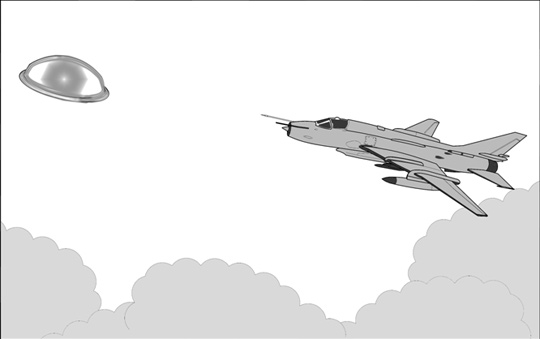
CASE Nº 11
Location: La Joya Airbase, Arequipa, Peru
Date: April 11, 1980
Time: 07:15 Hours Local Time
Witnesses: Pilot, Control Tower and military personnel
Type of Aircraft: Sukoi 22
Duration: 22 minutes
Radar Detection: Yes
Type of case: Fifth Kind
Source: CFI (Coalition for Freedom of Information) Washington Conference, November 12, 2007
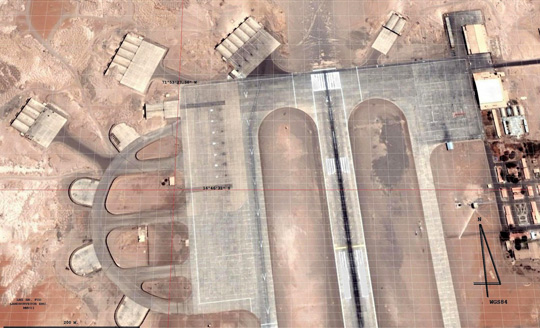
Like Capt. Bravo and Gen. Jafari, Cdr. Santa María was also a panelist at the 2007 National Press Club event and one of the contributors in Leslie Kean’s book. In this essay, “Close Combat with a UFO,” Santa Maria explains that, “at twenty I was selected to test-fly Peru’s newest supersonic Sukhoi jet. Having won quite a few trophies as a pilot, I was also known as a top aerial marksman with great skill at shooting from the air.” When an unidentified object was seen over the restricted airspace of La Joya, a Sukhoi 22 piloted by Santa María was scrambled. He thought initially that the object was a “balloon” which nevertheless “was in restricted air space without authorization, representing a grave challenge to national sovereignty.” Since the object would not identify itself or leave the area, the pilot fired a number of 30-mm shells. “Some of the projectiles deviated from the target, falling to the ground, and others hit with precision,” wrote Santa Maria. “I thought that the balloon would then be torn open and gases would start pouring out of it. But nothing happened. It seemed as if the huge bullets were absorbed by the balloon, and it wasn’t damaged at all. Then suddenly the object began to ascend very rapidly and head away from the base.”

Santa Maria continued the chase and at one point got very close to it, just about 300 feet. “I was startled to see that the ‘balloon’ was not a balloon at all,” continues Santa María. “It was an object that measured about 35 feet (10 meters) in diameter with a shiny dome on top that was cream-colored, similar to a light bulb cut in half. The bottom was a wider circular base, a silver color, and looked like some kind of metal. It lacked all the typical components of aircraft. It had no wings, propulsion jets, exhausts, windows, antennae, and so forth. It had no visible propulsion system.” After he was forced to land because he was running out of fuel, Santa María participated at a briefing with all the personnel involved in the incident, including “the general who was the aerial wing commander.” Not surprisingly, this case was quickly reported in a June 3, 1980 document from the U.S. Department of Defense Joint Chiefs of Staff Message Center, released years later by the Defense Intelligence Agency (DIA) under the Freedom of Information Act (FOIA).
This is the “Summary” of the case in the DOD document: “Source reported that a UFO was spotted on two different occasions near Peruvian Air Force (FAP) Base in Southern Peru. The FAP tried to intercept and destroy the UFO, but without success.” There is a date discrepancy in the DOD document, which gives the date as “morning hours of 9 May 80” and “early evening hours of 10 May 80” instead of April 11, 1980. Could they be referring to a different UFO incident at the same airbase a month later? Perhaps, yet the description of the SU-22 intercept and firing “at very close range without causing any apparent damage,” sounds identical to Santa María’s account. You can read the DOD 2-page document by pressing on the small icon. You can download Cdr. Santa Maria’s statement at the National Press Club (document removed by source). The La Joya Aerial Encounter of the Fifth Kind—when a military engagement occurs—is one of the most convincing UFO incidents anywhere in the official records. Try explaining that one in prosaic terms! Which brings us back to one of the main points raised by Capt. Bravo in Ufología Aeronáutica: that Unidentified Aerial Phenomena (UAP) pose a potential threat to aerial operations and that both scientific institutions and civil aviation authorities worldwide should take the necessary steps to deal with this problem.
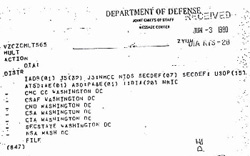






Why send a message of peace and welcome into outer space
then fire bullets and rockets when the ets’ show up to
meet us. It’s clear to me that some of us arn’t ready
for “first contact”. Fair play would mean abduction of
humans and planes. Clearly we are a hostile race and
deserve what they can dish out. Extend your hand in
peace then sucker punch them. We’re in big trouble boys!